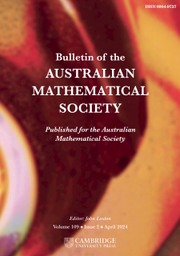No CrossRef data available.
Article contents
PERFECT CODES IN THE HOMOGENEOUS METRIC
Published online by Cambridge University Press: 30 October 2025
Abstract
We study perfect codes in the homogeneous metric over the ring  $\mathbb {Z}_{{2}^k}, k\ge 2$. We derive arithmetic nonexistence results from Diophantine equations on the parameters resulting from the sphere packing conditions, and a Lloyd theorem based on the theory of weakly metric association schemes.
$\mathbb {Z}_{{2}^k}, k\ge 2$. We derive arithmetic nonexistence results from Diophantine equations on the parameters resulting from the sphere packing conditions, and a Lloyd theorem based on the theory of weakly metric association schemes.
MSC classification
Primary:
94B25: Combinatorial codes
Information
- Type
- Research Article
- Information
- Copyright
- © The Author(s), 2025. Published by Cambridge University Press on behalf of Australian Mathematical Publishing Association Inc
Footnotes
This research is supported by National Natural Science Foundation of China (Grant no. 12471490).
References
Bariffi, J., Cavicchioni, G. and Weger, V., ‘The existence of MacWilliams-type identities for the Lee, homogeneous and subfield metric’, Preprint, 2024, arXiv:2409.11926.Google Scholar
Brouwer, A. E., Cohen, A. M. and Neumaier, A., Distance-Regular Graphs (Springer-Verlag, Berlin, 1989).CrossRefGoogle Scholar
Carlet, C., ‘
 ${\mathbb{Z}}_{2^k}$
-linear codes’, IEEE Trans. Inform. Theory 44(4) (1998), 1543–1547.10.1109/18.681328CrossRefGoogle Scholar
${\mathbb{Z}}_{2^k}$
-linear codes’, IEEE Trans. Inform. Theory 44(4) (1998), 1543–1547.10.1109/18.681328CrossRefGoogle Scholar
Constantinescu, I. and Heise, W., ‘A metric for codes over residue class rings’, Probl. Inf. Transm. 33(3) (1997), 22–28.Google Scholar
Cvetkovic, D. M. and van Lint, J. H., ‘An elementary proof of Lloyd’s theorem’, Indag. Math. (N.S.) 80(1) (1977), 6–10.CrossRefGoogle Scholar
Delsarte, P., ‘An algebraic approach to the association schemes of coding theory’, Philips Res. Rep. Suppl. 10 (1973), 1–97.Google Scholar
Hammons, A. R., Kumar, P. V., Calderbank, A. R., Sloane, N. J. A. and Solé, P., ‘The
 ${\mathbb{Z}}_4$
-linearity of Kerdock, Preparata, Goethals and related codes’, IEEE Trans. Inform. Theory 40(2) (1994), 301–319.CrossRefGoogle Scholar
${\mathbb{Z}}_4$
-linearity of Kerdock, Preparata, Goethals and related codes’, IEEE Trans. Inform. Theory 40(2) (1994), 301–319.CrossRefGoogle Scholar
Lucas, É., ‘Sur les congruences des nombres eulériens et des coefficients différentiels des functions trigonométriques suivant un module premier’, Bull. Soc. Math. France 6 (1878), 49–54.10.24033/bsmf.127CrossRefGoogle Scholar
Nechaev, A. A. and Khonol’d, T., ‘Weighted modules and representations of codes’, Probl. Inf. Transm. 35(3) (1999), 18–39.Google Scholar
Shi, M., Alahmadi, A. and Solé, P., Codes and Rings: Theory and Practice (Academic Press, Amsterdam, 2017).Google Scholar
Şiap, I., Özen, M. and Şiap, V., ‘On the existence of perfect linear codes over
 ${\mathbb{Z}}_{2^l}$
with respect to homogeneous metric’, Arab. J. Sci. Eng. 38(8) (2013), 2189–2192.CrossRefGoogle Scholar
${\mathbb{Z}}_{2^l}$
with respect to homogeneous metric’, Arab. J. Sci. Eng. 38(8) (2013), 2189–2192.CrossRefGoogle Scholar
Şiap, V. and Özen, M., ‘On the existence of perfect linear codes over
 ${\mathbb{Z}}_4$
with respect to homogeneous weight’, Appl. Math. Sci. 6(41) (2012), 2005–2011.Google Scholar
${\mathbb{Z}}_4$
with respect to homogeneous weight’, Appl. Math. Sci. 6(41) (2012), 2005–2011.Google Scholar
Solé, P., ‘A Lloyd theorem in weakly metric association schemes’, European J. Combin. 10(2) (1989), 189–196.CrossRefGoogle Scholar
Zinoviev, V. A. and Ericson, T., ‘Fourier-invariant pairs of partitions of finite abelian groups and association schemes’, Probl. Inf. Transm. 45(3) (2009), 221–231.CrossRefGoogle Scholar


